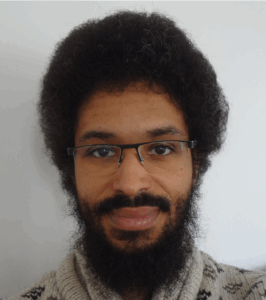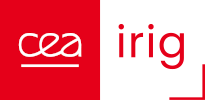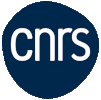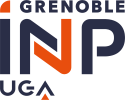 On September 23th 2025, we have the pleasure to welcome in SPINTEC Alexis Wartelle from Institut Néel. He will give us a seminar at 14:00 entitled :
On September 23th 2025, we have the pleasure to welcome in SPINTEC Alexis Wartelle from Institut Néel. He will give us a seminar at 14:00 entitled :
High-pressure, high-temperature extrusion of nanowire resonators for magnetic field microscopy
Place : IRIG/SPINTEC, auditorium 445 CEA Building 10.05 (presential access to the conference room at CEA in Grenoble requires an entry authorization. Request it before September 12th at admin.spintec@cea.fr)
video conference : https://univ-grenoble-alpes-fr.zoom.us/j/98769867024?pwd=dXNnT3RMeThjYStybGVQSUN0TVdJdz09
Meeting ID: 987 6986 7024
Passcode: 025918
Abstract : The applied research efforts targeting smaller device sizes at constant or improved performance frequently faces issues related to material quality [1]. Advanced fabrication techniques have demonstrated that compositions and dimensions can be controlled to a significant extent in thin film, multilayers [2], or patterned elements thereof. In these cases, the vertical scales are usually comparable or (much) smaller than the horizontal ones. On the other hand, it can be very challenging to maintain the same level of control while going into the third dimension.
Taking nanowires i.e. elongated rods with sub-micron diameters as an example, one could argue that top-down approaches via chemical etching enable precise shape control combined with material quality [3,4]. Distinct fabrication techniques such as molecular beam epitaxy [5,6], Focused Electron/Ion Beam-Induced Deposition [7,8,9] or electrochemical filling of templates [10,11] provide additional valuable strategies. However, none of the above can offer simultaneously (i) fine control over the geometry, (ii) excellent composition control, (iii) lateral protection against oxidation, (iv) and the prospect of single-crystalline growth.
In this presentation, I would like to describe a physical and template-based nanowire fabrication scheme which should, in many instances, provide these four characteristics. The general idea consists in reaching a high-temperature plasticity regime that is dominated by matter diffusion [12,13,14]. This phenomenon allows nanowire growth even in pores a few tens of nanometers in diameter, as available in porous alumina membranes.
First of all, I am going to provide an overview of literature reports on nanowires obtained with this method, and discuss the mechanisms at play (along with their limitations). I will then describe my research project at Institut Néel, which shall require a strong focus on high-pressure, high-temperature nanowire extrusion. The long-term goal, namely magnetic field microscopy, involves the use of such objects as tailored magnetic force sensors.
- Bharat Bhushan (ed.), Springer Handbook of Nanotechnology, 4th edition (2017). DOI: 10.1007/978-3-662-54357-3
- Johnson, Rep. Prog. Phys., vol. 59, pp.1409-1458, 1996. DOI: 10.1088/0034-4885/59/11/002
- Jaloustre et al., Mater. Sci. Semicond. Process., vol. 173(108095), 2024. DOI: 10.1016/j.mssp.2023.107654
- Valera et al., ACS Appl. Nano Mater., vol. 7, pp. 10338-10349, 2024. DOI: 10.1021/acsanm.4c00814
- Chardin et al., Nano Letters, vol. 25, pp. 4774-4780, 2025. DOI: 10.1021/acs.nanolett.4c06196
- Zhao et al., IEEE Nanotechnology Magazine, vol. 13(2), pp. 6-16, 2019. DOI: 10.1109/MNANO.2019.2891370
- Utke et al., J. Vac. Sci. Technol. B, vol. 26(4), 2008. DOI: 10.1116/1.2955728
- Fernández-Pacheco et al., Materials, vol. 13(17), 2020. DOI: 10.3390/ma13173774
- Skoric et al., Nano Letters, vol. 20(1), 2019. DOI: 10.1021/acs.nanolett.9b03565
- Sousa et al., Appl. Phys. Rev., vol. 1(031102), 2014. DOI: 10.1063/1.4893546
- Ruiz-Clavijo et al., Nanoscale, vol. 13(2227). 2021, DOI: 10.1039/d0nr07582e
- Z. Liu, Nat. Comm., vol. 8, p.14910, 2016. DOI: 10.1038/ncomms14910
- Z. Liu, Phys. Rev. Lett., vol. 122(016101) 2019. DOI: 10.1103/PhysRevLett.122.016101
- N. Liu et al., Sci. Adv., vol. 7, 2021. DOI: 10.1126/sciadv.abi4567
Biography : Bachelor & Master’s degree at École Normale Supérieure de Lyon (2011, 2013). PhD thesis at Institut Néel under the supervision of Olivier Fruchart, on the motion of magnetic domain walls in cylindrical, electrodeposited nanowires (2013-2018). First post-doc (two years) at the Technical University of Munich with Christian Back, about caustic spin wave beams in thin films, then return to France and Grenoble in early 2021. At that point, 2nd postdoc (2021-2023) on magnetic microscopy using coherent X-rays, with Guillaume Beutier; medium delocalization between SIMaP and ESRF, then phantom delocalization in Nancy… In 2024, switch from X-rays to electrons with a 3rd postdoc at Institut Néel, involving electric field measurements, and supervised by Martien den Hertog and Jean-Luc Rouvière (CEA MEM, LEMMA). Finally, after three applications, successful recruitment as junior CNRS researcher, still at Institut Néel.




